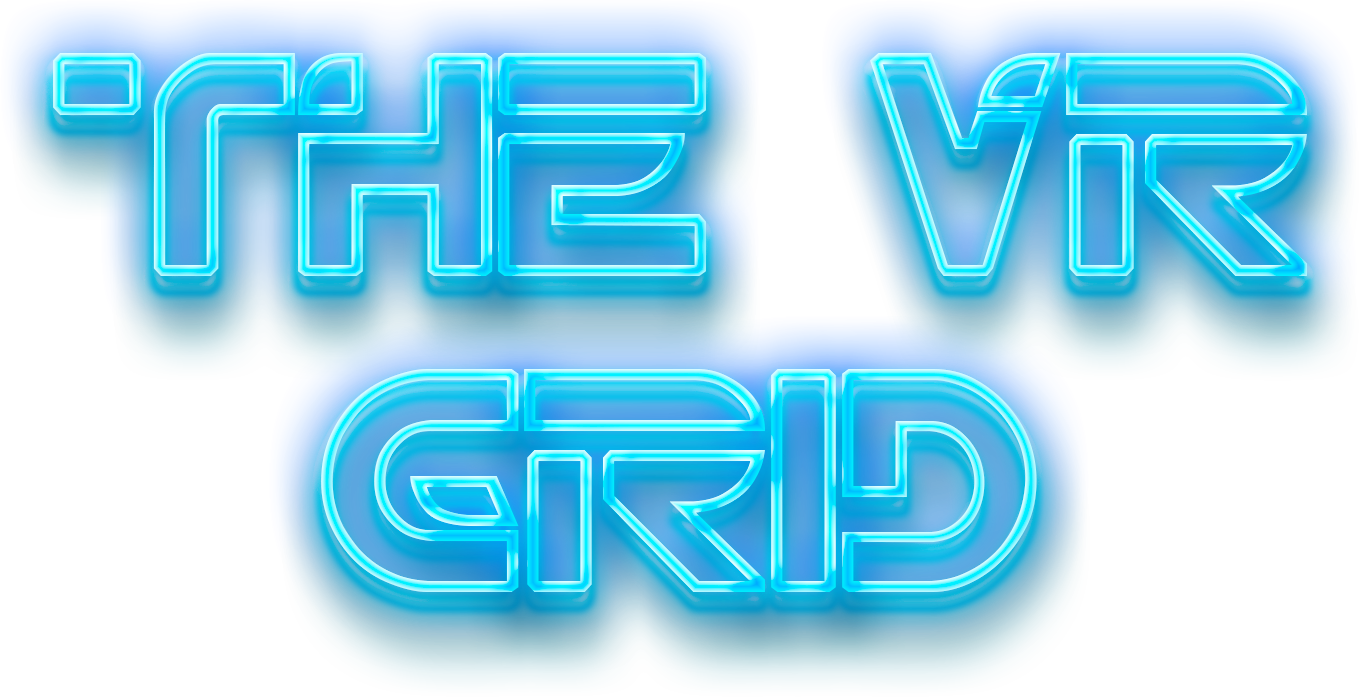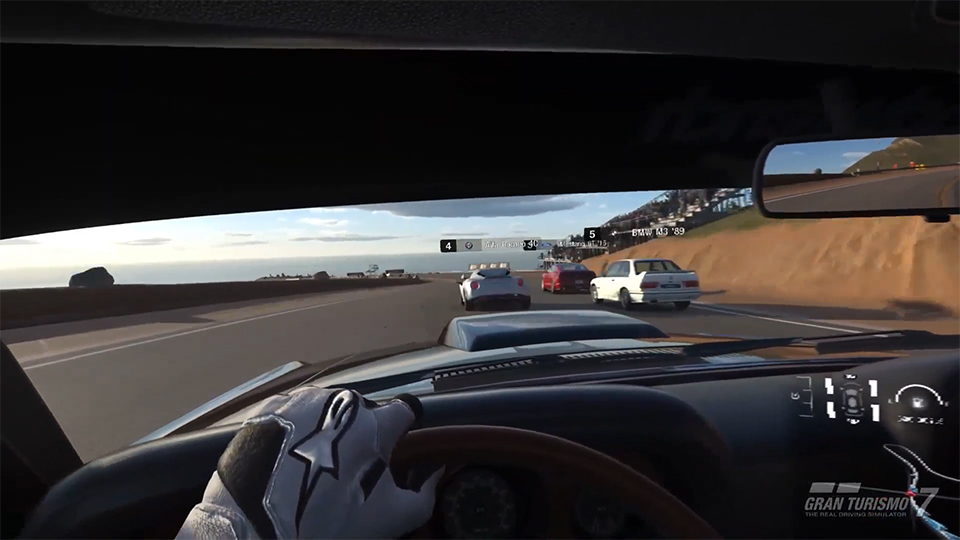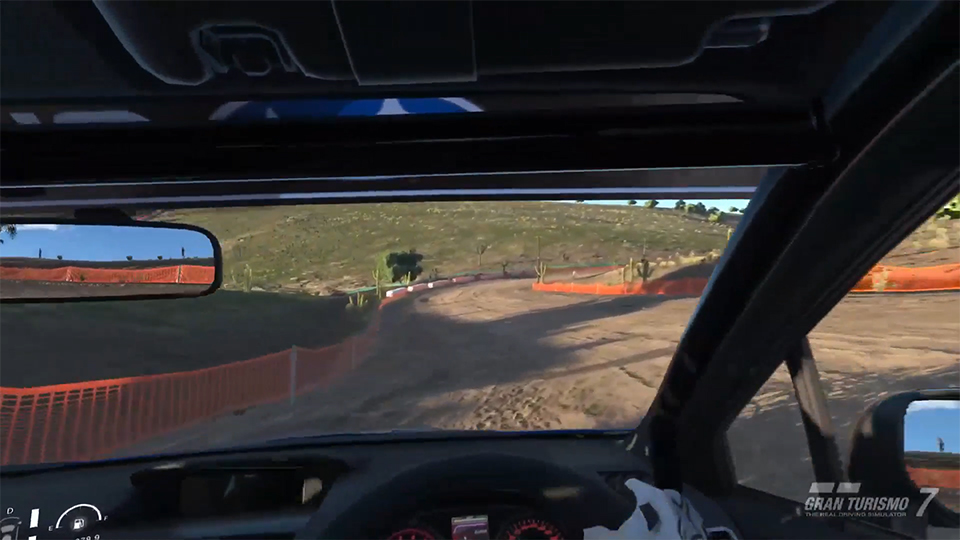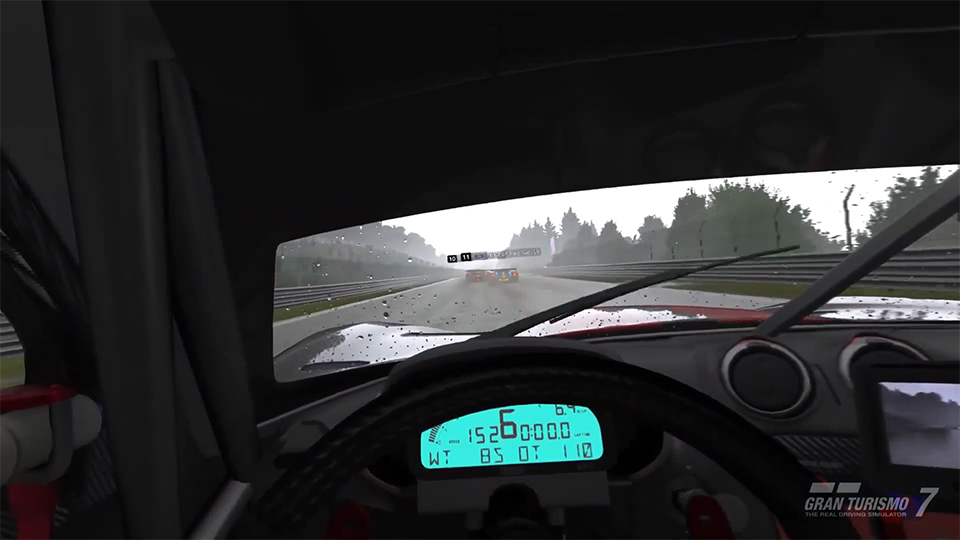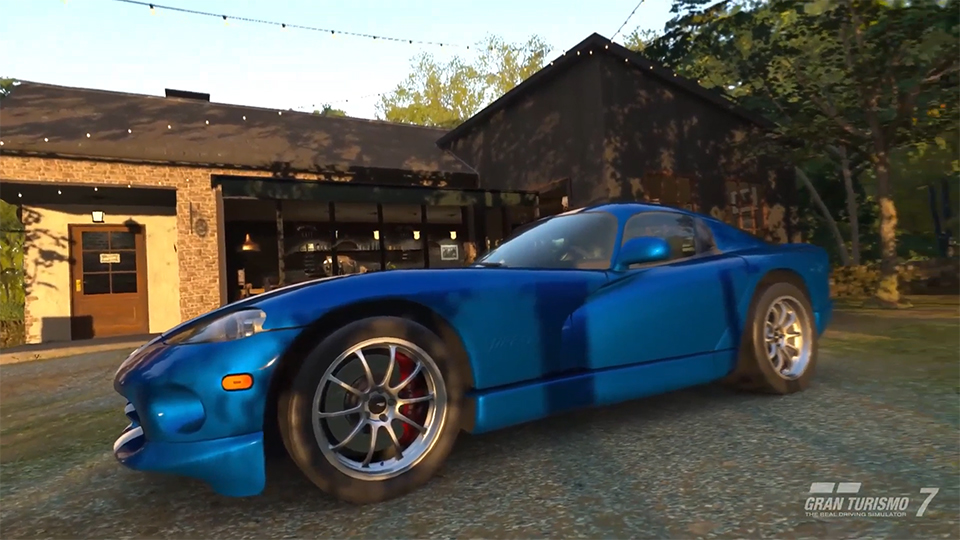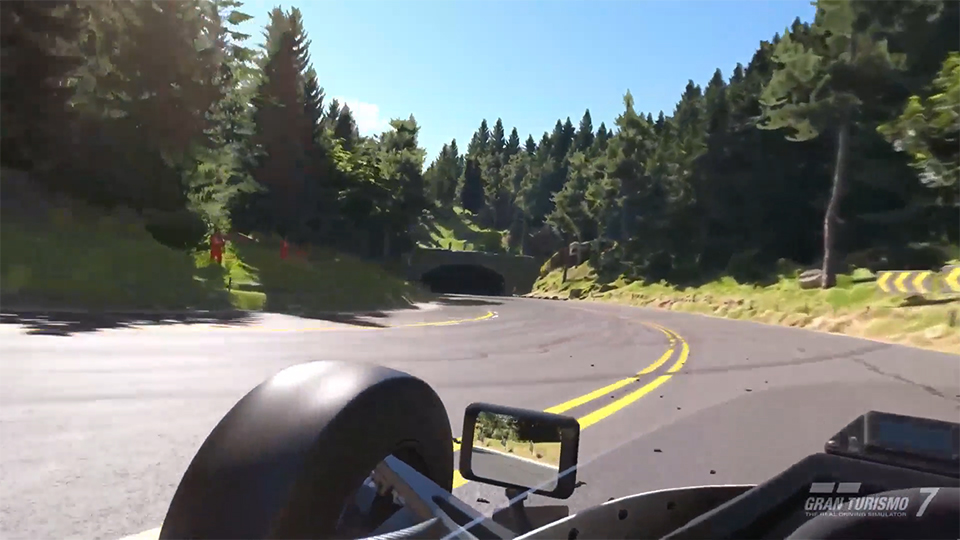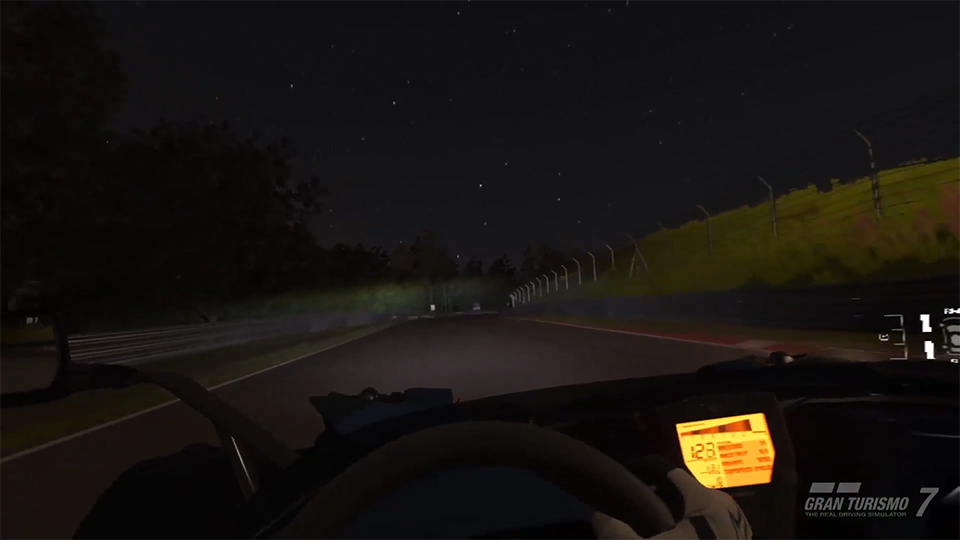Developer / Publisher – Polyphony Digital / SIE
Price – US $79.99 / CA $89.99 / EU €79.99 / UK £64.99
Release Date – February 22, 2023 (VR Patch)
Input – Dual Sense
Play Area – Seated
Store Links – PlayStation
Reviewed on – PS5/PSVR 2
Gran Turismo 7 VR is the latest entry in one of the longest running brands in sim racing. GT 7 finally delivers on the VR experience that was only teased back on the original PSVR with GT Sport. Racing and car enthusiasts stick around, because this is something truly special and sets a new benchmark for all VR racing games to come.
As a day one Playstation 1 owner, I have been a fan of the GT series through all of its ups and downs. Launching first on the original playstation back in 1997, there had simply never been a racing game that took such painstaking efforts to offer up a true driving simulator while simultaneously being a love letter to automobiles and the world of racing. Throughout the following 25 years countless racing sims have established themselves on both PC and console. The GT series has at times struggled to keep up, especially where physics and sounds were concerned. However, GT founder, producer and lead designer, Kazunori Yamauchi, and his team have helped to once again define what a console based sim racing title should be with Gran Turismo 7. With GT 7 finally being brought fully into VR this truly feels like Kazunori has finally seen his true vision for the Gran Turismo series become a reality.
GT 7 is packed with something for just about any type of racing fan, offering up over 400 photoreal automobiles and 40 plus tracks, the majority of which are laser scanned for accuracy. Singler player and multiplayer racing options are almost endless but, in true Gran Turisomo fashion, most of the game’s content is locked behind the “campaign” called The Cafe. In an odd choice, GT 7 has turned game progression into a selection of what they call menus, of which are offered at the cafe and are essentially a collection of challenges designed to take you through the game’s many features. From using your garage, purchasing vehicles, upgrading and tuning said vehicles, to an introduction to the game’s deep livery editor and store options. And that’s just the beginning- future menus will take you through the licensing process (yup, you need to get good before you can get the keys to anything faster than your mom 4-cylinder grocery getter). Earning licences unlocks access to higher tiers of cars at which point The Cafe will provide menus introducing you to a variety of driving disciplines and eras of automobile racing.
It is also around this point, maybe an hour into crushing through menus, that you gain access to the online feature of the game. So for those anxious to jump in and race with your friends, just know you will need to put some time in first. Don’t expect to join your friends with many vehicle options to race with either as there is no car rental option. We’ll come back to the multiplayer lobby a bit later.
I will say that continued progression through The Cafe was an appreciated feature that was sorely missing in GT Sport and most sim racing titles for that matter. I loved that the game gave me a more tangible reason and guide to not only race but what to race, giving a good overview of different tracks, times of day, weather conditions and a selection of car choices I might not have naturally gravitated to. That being said, I can see more casual racers finding this a bit of a grind. Players who push through The Cafe’s menus will unlock all the game’s tracks, the ability to sell their own cars, and will gain access to The Legend car dealership – a sales centre that contains some of the most sought after classic cars in GT Sport. Offering vehicles simply not available in the used car or brand dealerships, The Legend is worth gaining access to. Further to this, completing menus earns players cash money and awards them with an automobile (often related to the menu at hand) and often a much sought after vehicle. The time and expense is usually worth it and consequently sets players up with a fairly robust and varied car collection to play with on or offline. Finally, simply racing and completing menus or taking on one of the game’s many challenge stages earns players xp which will award players with roulette table spins of various values, each paying out either a car, part, xp boost or a sum of cash.
Simply put, GT 7 does a nice job of consistently rewarding players for playing, extending this reward system into every aspect of racing, whether solo in an arcade race, custom race or time trial run or any of the games many cups. You can even earn xp and money setting up or joining custom races in the online lobby, an addition I loved. It made a night ripping around tracks with friends a money earning opportunity. And it’s a good thing too as the economy system in GT 7 is definitely a little hard on the player. Cars cost into the 10s of millions, and upgrades can easily set you back a couple hundred thousand dollars. Speaking of upgrades, GT 7 brings back the full on upgrade system from previous titles and then some, allowing players to effectively rebuild and tune a car to their own specifications. Engine modifications, weight reductions, body kits and complete engine swaps are just some of changes players can make, not to mention tire changes, rim swaps and a deep livery design system that includes an online marketplace for those looking to distribute or download designs for both vehicles and racing wear. And let me tell you, never in my racing history have paint jobs and car designs been so fun to play with and customise my rides with. Whether I was gushing over my own rides in the incredible VR showcase mode or racing against people online, never have I felt such a personal connection with my rides, knowing people would be checking it out inch by inch in VR like I was really at a car show. It’s an incredible feeling and one very unique to my experience in GT 7 in VR.
Now it must be mentioned that, yes, GT 7 does have micro transactions, and the grind to earn real money does at times feel like it lends itself to push players to spend real world money to get ahead. But the ability to sell used cars certainly helps to offset the sense of pay-to-win that can hang over the game at times.
GT 7’s multiplayer options are quite robust and in the form of online multiplayer lobbies and sport mode. We first saw GT’s ranked online league system in the series’ previous entry. The online multiplayer lobbies are for more casual players looking to jump into races quickly or start up their own lobby with a bunch of friends. It’s here that races can be customised across just about every attribute imaginable, making for a near endless choice of races. Thankfully the VR version of GT 7 is cross-play with any flat gamers, making it easy to play with friends not in VR. On the other side of the multiplayer offering we have sport mode, which is in many ways Gran Turismo’s answer to iRacing. Here players are ranked on skill and sportsmanship and matched with similar racers making for highly competitive races that are really meant for those looking for serious races void of players crashing into others and not following track rules.
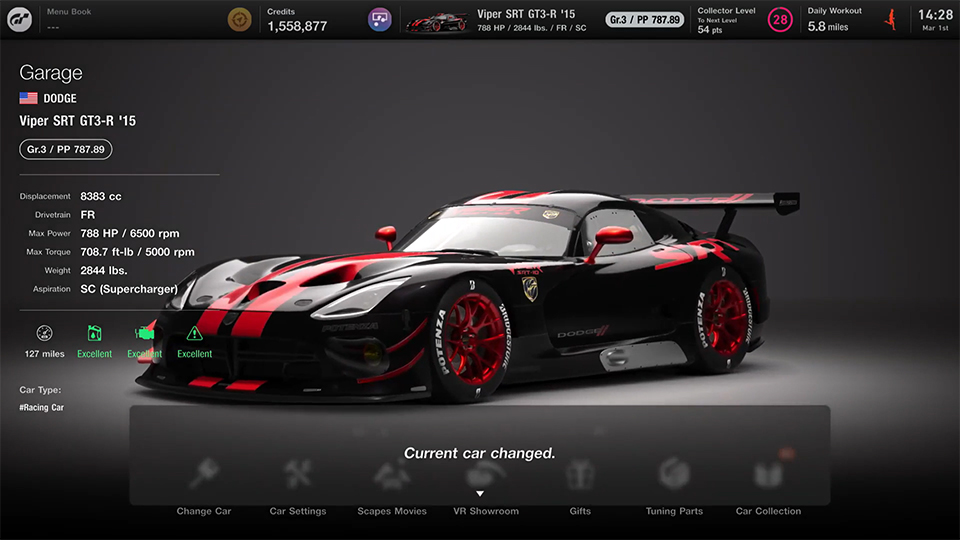
Navigating the menu’s is in cinematic mode, but all the racing is in VR.
Gran Turismo as a series has been a staple of the sim racing world on consoles for decades. But like many other sim titles, I always felt the series struggled in communicating a real sense of speed to players nor managing to nail the feeling of traction loss (or more importantly the moments leading up to it). The result was gameplay that often left players that were unaccustomed to the series flying into corners at high speeds and spinning out at even the slightest turn or breaking point. Thankfully, here in GT 7, a new tire physics model changes the whole feel of the game, making it much easier to regain and keep control of vehicles. Now, I’m not saying you wont be licking the walls half the time, but at least you will know it was your fault.
As for communicating a proper sense of speed to players, this is where being in VR completely and fundamentally changes the entire racing experience. Literally sitting inside the car, surrounded by the depth of stereoscopic VR, is a game changer in racing games. Cars now feel like they have real mass and weight, as players can actually feel the body roll of their vehicle and the scale of competitors next to them. More importantly, the overall sense of depth and scale communicated to the player gives a real world sense of how fast you are actually moving through it. Breaking points begin to feel much more organic as well, as players begin to learn a real sense of breaking speed as it relates to distance instead of simply trying to use landmarks to remember breaking points. The end result is that VR makes racing in GT 7 not only much more immersive and fun, but also easier, or at least more accessible.
That being said accessibility has never been a staple of the GT series and that remains true here with a menu and U.I. system that certainly takes some time to learn. Much of this is due to the game being so feature rich with simulation features on top of simulation features. Thankfully the basics are taught throughout the early menus, so players looking to spend more time racing and less time tweaking can for the most part get away with a basic understanding of car upgrades, and a familiarity with some of the various driving assists on offer. However, for those looking for more, the rabbit hole can go very deep, offering players the ability to completely tune vehicles, track driving telemetry, fuel and tire usage, and immerse themselves completely in the fine details of the racing world. That in itself is the brilliance of GT 7 as it can truly be a game for anyone. It lends itself well to players who simply want to run track days, create liveries and take pictures of their rides just as aptly as it can facilitate a deep racing career to those who would rather crush out an actual 24-hour Le Mans race on their racing rig.
Furthering GT 7’s open appeal to various types of racers is the absolute insane level of detail that goes into each and every vehicle found in the game. Something the Forza series has suffered from is offering a huge car selection, but often being very hit and miss on the quality of vehicle reproduction, with many handling very differently than their real world counterparts, often feeling like simple copy-and-pastes of other vehicles. Here, GT 7 excels, offering an at times insane level of detail and nuance to car handling, making each and every vehicle in its collection a genuine love letter to that specific ride. This is a game where players are really rewarded for taking the time to learn a vehicle and develop a driving style around it, and learning specific courses and truly mastering aspects of the game that appeal to them. Adding to the wide range of vehicles and driving disciplines is the game’s wide range of courses, ranging from famous racecourses, road courses, highway driving, rally dirt courses, and as well as some classic fictional GT courses like Trial Mountain and Dragon Trail (nicely upgraded, of course).
Hardcore sim racers who swear by the subscription-based game iRacing may not find GT 7 to be hardcore enough sim for them, but there is no denying the incredible balance Polyphony Digital has found between offering a high level simulation and the amount of content on offer. Hardcore sim racers aside though, I think anyone looking for a more realistic racing game will find GT 7 to be one of the best racing experiences they have ever had. Personally I always found the GT series to be almost clinical in its approach to racing and the way cars felt on the road. I thought the driving model felt stiff, with cars never feeling as exciting to drive and throttle down on as was portrayed in real racing or other games for that matter. Thankfully what began with GT Sport and continues here is an overall physics engine that finally makes these high powered vehicles feel powerful, lively, and unpredictable when necessary, and most importantly fast and fun. In fact as an avid racing fan and one who leans more toward the sim side of things, I would say this is easily one of my favourite racing games in and out of VR.
This level of excitement on the track is also communicated beautifully through the PS5 dual sense giving players an incredible sense of feedback previously only possible with a force feedback steering wheel. Breaking strength, traction loss, gear shifting and other road changes are all communicated wonderfully through the combination of the controller’s HD rumble and haptic triggers, so much so that I didn’t immediately want to plug into my racing rig. That being said, if you are lucky enough to have a proper force feedback wheel setup, GT 7 will impress you with some very tasteful and informative wheel feedback, and of course offer some next level immersion to the VR experience. Speaking of controllers, I should mention that the game does not support the two PSVR 2 motion controllers, and there are no in-game VR controls. Something which is standard among all the major VR sim racing games, as you simply need the higher fidelity control of a wheel or analog sticks.
Closing things out on the gameplay side of things, I should mention the Racing A.I., as I feel that Polyphony has done a nice job of really dialling in the difficulty levels here, offering more intermediate difficulty levels that don’t feel stupid, but certainly don’t push the envelope, allowing early racers to feel proud of some early wins. However, higher difficulties close that gap nicely while also turning up driver aggression, so if you get rammy on the course, expect to be put in your place. Of course, more experienced racers will undoubtedly end up online for a higher challenge, but the A.I. driving here is often very competent and adaptable, never screaming that it is a computer controller opponent.
Getting into the visual side of things, what can I say except that GT 7 in VR is an absolute sight to see in the headset. As someone who’s first VR driving experience was in Driveclub VR on the PSVR 1, I remember instantly feeling that this was going to be the only way to play a racing game moving forward. I looked at PCVR racing games like the Project Cars series, Dirt Rally and Assetto Corsa and longed for that next level of visual immersion. Dirt Rally would eventually come to the PSVR and it was incredible, but it was still visually filled with compromises. Finally I would get a PC and yes, games like Project Cars 2, a modded Assetto Corsa, and a few others blew my mind with a level of AAA graphics I had only dreamed about on the PSVR 1.
I mention my little VR racing journey to help illustrate that, despite my PCVR racing experiences, how absolutely blown away I was when jumping into GT 7 VR for the first time. I have endlessly tweaked graphical settings to get my PC to run a visually stunning game like Project Cars 2 properly with a smooth frame rate and all the visual effects on. Polyphony has managed to pull off stunning visuals with the PSVR 2, powered by a PS5 (which for all accounts isn’t really all that powerful when compared to current high GPU’s). Polyphony has managed to bring what was already a visually impressive flat game into VR without any visible compromises. This is not a VR version of GT 7, this is GT in VR. Taking full advantage of the dynamic foveated-rendering technology that eye tracking offers, GT 7 has somehow managed to find a perfect blend of resolution and high frame rate while keeping most, if not all, of the flat game’s lighting and particle effects, including full texture detail of the cars, inside and out, and the tracks. Nighttime racing in an open cockpit is a straight up religious experience and is sure to make even the most jaded VR gamer tear up with its beauty as they rip through tree lined courses, headlights bouncing off of trees, then looking up to see a wide open star filled sky. There is also excellent use of the deep blacks of the OLED display and HDR lighting making sparks and headlights truly blinding. Jumping between various courses, vehicles and racing throughout different times of day and in all types of weather, is truly an experience in VR as they all feel so unique.
Jumping from an F1 car, to a 60’s muscle car, to a super car and then into a go kart made every single experience feel completely unique. Much of this is due to the fact that I was literally in these vehicles inside these worlds and they felt real. Every single detail of these vehicles has been brought into VR, and dare I say begin to get close to being photoreal, or about as photo real as this current tech will allow. This is no better demonstrated than in the VR showcase feature, in which players can place any of their personal rides into one of many beautiful locations and walk around the vehicle, taking in every inch of the car, turning on the headlights, signal lights and even jumping inside to take in the fully-realised interiors. This is better than even the best car show and a dream for car fanatics like myself, as you can simply pour over some of the finest automobiles ever developed in all of automobile history.
It is the on-track experience that continually impresses me more than anything, as it is silky smooth and simply beautiful across all of the tracks and the cars, every time of day, all weather conditions and even online with up to a 16 racer grid. It’s truly remarkable.
Now to be fair, the graphics aren’t without a few flaws. There is some slight pop-in that can be seen if you’re really looking for it, with a few texture flickers. Draw distance is fantastic, though the game still has some limitations when comparing it to the flat version, with the image being a bit softer as you look way off into the distance.
Probably the two most noticeable visual aspects to mention are directly related to the amazing tech the PSVR 2 uses to actually pull this off. First off is the use of dynamic foveated rendering, meaning you really need to dial in the eye tracking, IPD and headset placement on your face for best results, resulting in a relatively small sweet spot to get the full visual experience. Related to this, GT 7 is not as sharp as some PCVR racers, especially if they are using super sampling, likely not maxing out the headset’s resolution capabilities but close enough, especially when taking into account the amount of effects on screen and the smooth as butter frame rate. However, this frame rate does come at a cost as GT 7 uses a reprojection technique that essentially takes the game running natively at 60fps and doubles it to that silky smooth 120 fps we see in the headset. The result though is a slight ghosting effect, that thankfully isn’t too noticeable in GT 7, and only really seen from time to time especially when whipping your head around quickly or when viewing a competitor’s vehicle driving across you left to right. It was most noticeable when driving around my friends in multiplayer. You will never see this issue in recorded footage though, as it is only visible in the headset.
Finally there is also the “Mura effect” that the PSVR 2 headset is unfortunately becoming known for due to its use of OLED panels. It’s essentially an almost screen door effect that can be seen in GT 7 when looking at skylines. Turning your headset’s brightness down to around 70% does help to alleviate this somewhat. Regardless, once in a race and focusing on the corners, my car and competitors I rarely noticed it.
In fact despite these small gripes, I would still say that pound for pound GT 7 in VR is the best looking VR racer I have played. Some PC games may be a bit sharper and lack the reprojection issues, but the highly optimised combination of effects, texture detail, resolution and frame rate seen here in GT 7 is tough to beat by anything on PC as far as the complete visual package is concerned.
Sound wise GT 7 also flexes those AAA muscles delivering some of the finest engine sounds in the franchise history, and especially when considering how many vehicles have been uniquely created. It may not hit the highs on a car by car basis of some more specialised racers like Assetto Corsa Competiione, but it remains a very solid sound package that I gladly turned the music off to immerse myself in. Upgrades to your vehicles, whether it’s to the exhaust system or the inclusion of a turbo or supercharger can change the sound of vehicles, and these are the types of details I expect in a proper simulation. The GT series wasn’t always known for its accurate engine sounds in previous numbered entries in the series, so it’s nice to see it back on top here, even if it lacks some of the finer details found in some sim racers. Additionally, for those looking to get the best sound experience here, be sure to plug in some earphones as the 3D audio mix here in GT 7 is also first rate and does a brilliant job of properly communicating vehicles coming up behind. There is enough detail for car enthusiasts to be able to identify the car just by its engine note.
Music, well, I came here for the cars so I turned it off, but if you know Gran Turismo then you know to expect a combination of alt rock and underground EDM along with some jazz and classical music tracks thrown in.
Now, final thoughts and a review score. GT 7 is currently the finest example of a sim racing game made for the masses. I wouldn’t call this a racer for everyone, as those looking for a Need for Speed experience will surely find the sim physics and meticulous progression system here in GT 7 overwhelming. But for those looking to fully immerse themselves in a deep racing experience, or to simply feel the rush of sitting inside some of the world’s greatest vehicles, there simply is no better game currently on the market. Hardcore sim racers are sure to find GT 7 a little too forgiving in certain areas, but like I said this is a racing sim that still attempts to be accessible to a general audience and does successfully manage to find a balance.
GT 7 is easily one of the PSVR 2 finest launch titles, and I suspect it will stand the test of time for much of the headset’s lifespan. Its execution is truly remarkable for a game running on a console and yet competing with, if not besting, some of the finest PCVR racers currently available from both a visual and performance standpoint. GT 7 is the complete racing experience, a must-own for racing fans, and one of my favourite VR games of all time.
